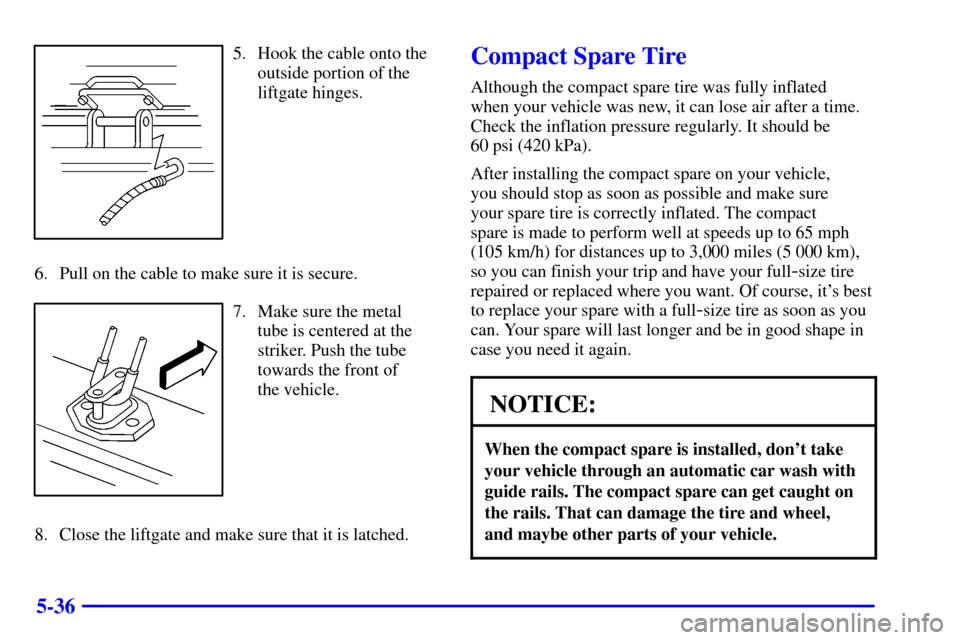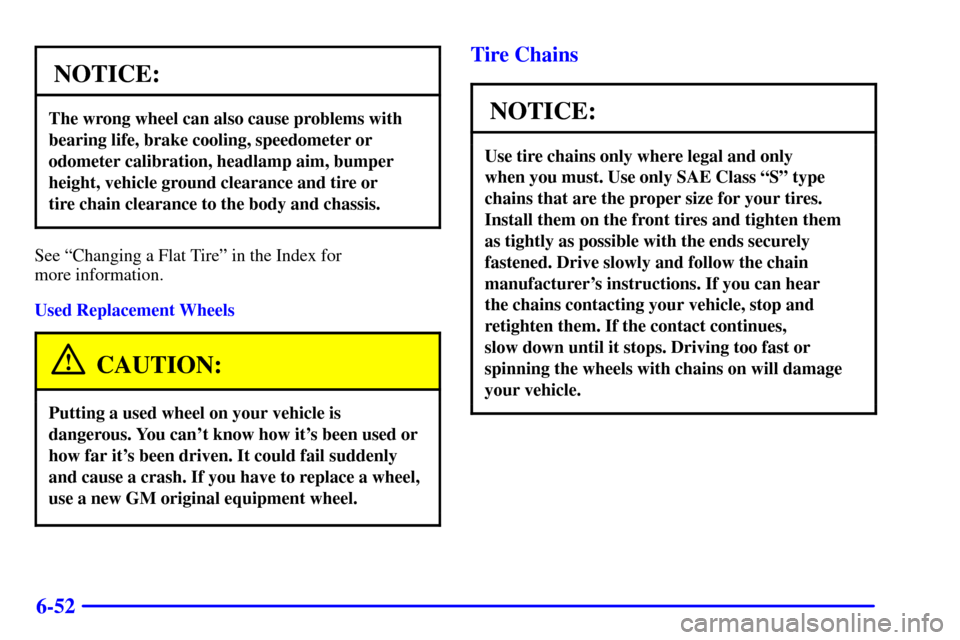Page 197 of 455
2-115
Low Fuel Warning Message
United States Canada
If your fuel is low, the warning message will come on
and stay on until you add fuel.
If the warning message is still on after adding fuel, you
need to reset the warning message. To reset the warning
message, turn the ignition to off and then back on. If the
message stays on, see your dealer right away.
AWD Disable Warning Message
(If Equipped)
United States Canada
You will receive this message when there is a spare tire
on the vehicle or when the anti
-lock brake system
warning light comes on.
The all
-wheel-drive system will be disabled until the
compact spare tire is replaced by a full
-size tire. If the
warning message is still on after putting on the full
-size
tire, you need to reset the warning message. To reset
the warning message, turn the ignition off and then
back on again. If the message stays on, see your dealer
right away. See ªAll
-Wheel Driveº in the Index for
more information.
Page 327 of 455

5-24
3. To remove the compact spare tire from the cable, tilt
the retainer at the end of the cable so it can be pulled
up through the wheel opening.4. If your vehicle is an all
-wheel-drive vehicle, after
removing the compact spare tire, turn the wrench
clockwise to raise the cable back up.
On an AWD vehicle, you can not store a full
-size
tire under the vehicle. It should be stowed inside
the vehicle by the cable provided. See ªStoring the
Flat Tire on an All
-Wheel-Drive Vehicleº later in
this section.
If you have a front
-wheel-drive vehicle, the hoist
is used to store a full
-size or a flat road tire under the
vehicle. See ªStoring the Spare Tire and Toolsº and
ªStoring the Flat Tire on a Front
-Wheel-Drive
Vehicleº later in this section.
If the compact spare tire will not lower, check under the
vehicle to see if the tire is hanging loose and the cable
end and spring under the wheel plate are missing. If so,
the secondary latch system is engaged. See ªSecondary
Latch Systemº later in this section.
To continue changing the flat tire see ªRemoving
the Flat Tire and Installing the Spare Tireº later in
this section.
Page 329 of 455

5-26 Secondary Latch System (If Equipped)
Your vehicle may have an underbody mounted tire hoist
assembly equipped with a secondary latch system. It's
designed to stop a tire from suddenly falling off your
vehicle if the cable holding the tire is damaged. For the
secondary latch to work, the tire must be stowed with
the valve stem pointing down.
Front
-wheel-drive vehicles use the underbody tire hoist
assembly to store either the compact spare or a flat road
tire. See ªStoring a Flat or Spare Tire and Toolsº in
the Index for instructions on storing the spare or flat
tire correctly.
If your vehicle is equipped with all
-wheel-drive, the
underbody tire hoist assembly stores only the compact
spare tire. See ªStoring the Spare Tire and Toolsº in
the Index for instructions. To store a flat full
-size tire
correctly, see ªStoring the Flat Tire on an
All
-Wheel-Drive Vehicleº in the Index.
CAUTION:
Before beginning this procedure read all the
instructions. Failure to read and follow the
instructions could damage the hoist assembly and
you and others could get hurt. Read and follow
the instructions listed below.
To release the spare tire from the secondary latch,
do the following:
CAUTION:
Someone standing too close during the procedure
could be injured by the jack. If the spare tire does
not slide off the jack completely, make sure no
one is behind you or on either side of you as you
pull the jack out from under the spare.
Page 337 of 455
5-34
6. Make sure the tire is stored securely. Push, pull, and
then try to rotate or turn the tire. If the tire moves,
use the folding wrench to tighten the cable.
Put back all jacking tools as they were stored in the jack
storage compartment and put the compartment cover
back on.
To put the cover back on, line up the tabs on the right of
the cover with the slots in the cover opening. Push the
cover in place and push down the tab so that it rests in
the groove. This secures the cover in place.A. Strap
B. Bag and Tools
C. Jack
Unless you have the plastic ªbolt
-onº wheel covers,
be sure to also store the center cap. When you replace
the compact spare with a full
-size tire, reinstall the
bolt
-on wheel covers and the center cap. Tighten
them ªhand
-tightº over the wheel nuts, using the
folding wrench.
Page 339 of 455

5-36
5. Hook the cable onto the
outside portion of the
liftgate hinges.
6. Pull on the cable to make sure it is secure.
7. Make sure the metal
tube is centered at the
striker. Push the tube
towards the front of
the vehicle.
8. Close the liftgate and make sure that it is latched.
Compact Spare Tire
Although the compact spare tire was fully inflated
when your vehicle was new, it can lose air after a time.
Check the inflation pressure regularly. It should be
60 psi (420 kPa).
After installing the compact spare on your vehicle,
you should stop as soon as possible and make sure
your spare tire is correctly inflated. The compact
spare is made to perform well at speeds up to 65 mph
(105 km/h) for distances up to 3,000 miles (5 000 km),
so you can finish your trip and have your full
-size tire
repaired or replaced where you want. Of course, it's best
to replace your spare with a full
-size tire as soon as you
can. Your spare will last longer and be in good shape in
case you need it again.
NOTICE:
When the compact spare is installed, don't take
your vehicle through an automatic car wash with
guide rails. The compact spare can get caught on
the rails. That can damage the tire and wheel,
and maybe other parts of your vehicle.
Page 390 of 455

6-49
CAUTION:
Mixing tires could cause you to lose control while
driving. If you mix tires of different sizes or types
(radial and bias
-belted tires), the vehicle may not
handle properly, and you could have a crash.
Using tires of different sizes may also cause
damage to your vehicle. Be sure to use the same
size and type tires on all wheels.
It's all right to drive with your compact spare,
though. It was developed for use on your vehicle.
CAUTION:
If you use bias-ply tires on your vehicle, the
wheel rim flanges could develop cracks after
many miles of driving. A tire and/or wheel could
fail suddenly, causing a crash. Use only radial
-ply
tires with the wheels on your vehicle.
Uniform Tire Quality Grading
Quality grades can be found where applicable on the
tire sidewall between tread shoulder and maximum
section width. For example:
Treadwear 200 Traction AA Temperature A
The following information relates to the system
developed by the United States National Highway
Traffic Safety Administration, which grades tires by
treadwear, traction and temperature performance.
(This applies only to vehicles sold in the United States.)
The grades are molded on the sidewalls of most
passenger car tires. The Uniform Tire Quality Grading
system does not apply to deep tread, winter
-type snow
tires, space
-saver or temporary use spare tires, tires with
nominal rim diameters of 10 to 12 inches (25 to 30 cm),
or to some limited
-production tires.
While the tires available on General Motors passenger
cars and light trucks may vary with respect to these
grades, they must also conform to federal safety
requirements and additional General Motors Tire
Performance Criteria (TPC) standards.
Page 393 of 455

6-52
NOTICE:
The wrong wheel can also cause problems with
bearing life, brake cooling, speedometer or
odometer calibration, headlamp aim, bumper
height, vehicle ground clearance and tire or
tire chain clearance to the body and chassis.
See ªChanging a Flat Tireº in the Index for
more information.
Used Replacement Wheels
CAUTION:
Putting a used wheel on your vehicle is
dangerous. You can't know how it's been used or
how far it's been driven. It could fail suddenly
and cause a crash. If you have to replace a wheel,
use a new GM original equipment wheel.
Tire Chains
NOTICE:
Use tire chains only where legal and only
when you must. Use only SAE Class ªSº type
chains that are the proper size for your tires.
Install them on the front tires and tighten them
as tightly as possible with the ends securely
fastened. Drive slowly and follow the chain
manufacturer's instructions. If you can hear
the chains contacting your vehicle, stop and
retighten them. If the contact continues,
slow down until it stops. Driving too fast or
spinning the wheels with chains on will damage
your vehicle.